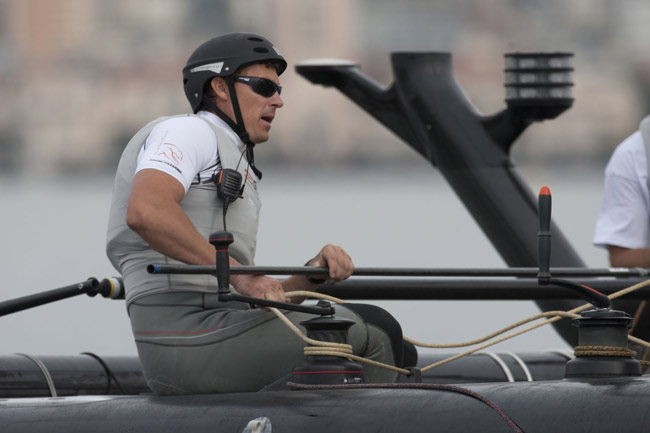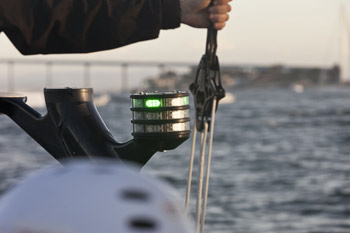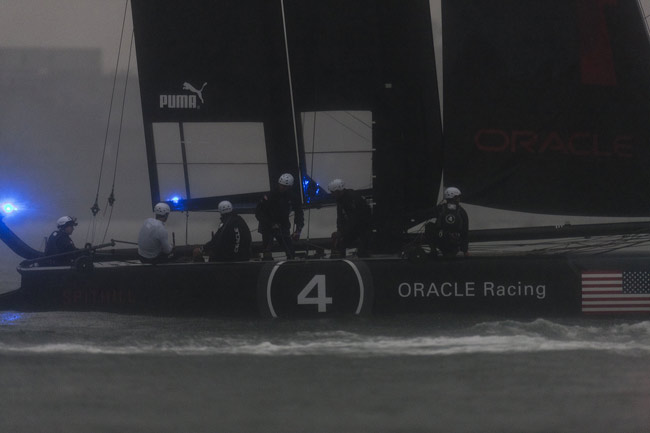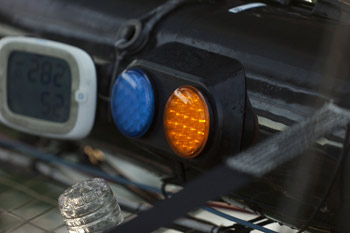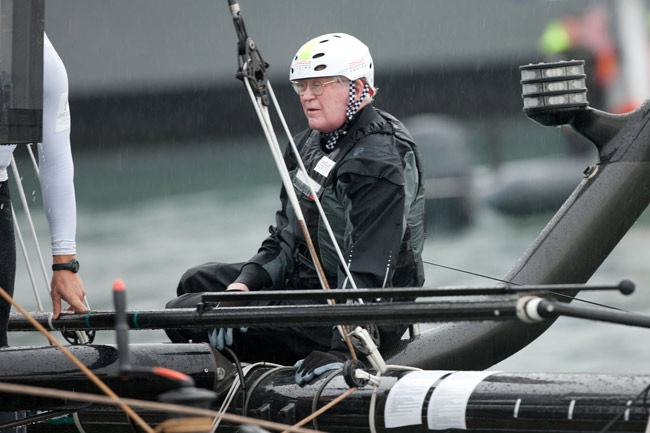|
November 13, 2011 |
||||||||
|
Regatta Director Iain Murray and his team designed an innovative light system on the crossbeams to communicate to the sailors, but experience showed that the system needed to be seen outside an AC45 catamaran as well, and not only by viewers but by the other teams, too. Enter the transom lighting system, dubbed the “Christmas Tree” for its bright green and red LED array readily visible across the race course.
“We’re really taking electronics to sailing,” said Murray. “It’s something we’ve wanted to do for a long time but haven’t been able to do. We’re learning what’s important and what’s not. Sure, we can make it operate, but to make it understandable is another thing. So we decided to add the transom lights; but the design and manufacturing process takes time -- they have to be totally waterproof, they have to be married into existing computer systems, we have to create the battery packs and write the software. We’ve invested a lot of time and money in trying to take the feedback from the teams and what we’ve learned about the boats.” There are three locations on the AC45 that have indicator lights -- the bowsprit, the forward crossbeams and now, the transom. Here is what the lights mean: There are four colors of lights that appear on the indicators: amber, blue, green and red. The amber light indicates when a boat is approaching the boundary. It blinks faster and faster until the boat goes over the boundary, then it goes solid. When you receive a penalty, a blue light will appear, which according to Murray means “The police are coming to get you.” If someone has been fouled (the “Y flag” penalty) a button will be pressed on the race committee boat and a red light will come on the transom lights -- this is equivalent to the code flag “B” which makes a protest obvious to everyone. A green light indicates when boats are within 42 meters of the boundary, alerting both themselves and the boats nearby that they have rights. Here’s the scenario -- if two boats are approaching the boundary on starboard tack, needing to tack to port, the boat that reaches the boundary first can tack to port and take rights over the starboard tack boat. He can only do it within three boat lengths, or 42 meters of the boundary, which is indicated by a green light that is triggered by an onboard GPS system (it's the rare situation in sailboat racing in which a port tack boat would have right of way over a starboard-tack boat). The boat maintains that right of way within 42 meters of the boundary. So if a boat runs dead downwind of the boundary, they have rights the whole way. But when a boat on port tack gets more than 42 meters away from the boundary and that green light is off, they’ve got a problem. “The issue we had before was a boat wouldn’t know when he was in that zone,” explained Murray. “The green light indicates when they have that right of way, so that if there’s a starboard tack boat coming and a port tack boat coming out of the boundary, if the green light is on, the port tack boat has rights over the starboard tack boat. Now the competitors can see that -- the light is on the end of the bowsprit and on the transom so hopefully everyone will know when you do or do not have those rights, as the lights on the transom and the bowsprit have 360-degree visibility.” The other area of confusion was at the start. As quickly as an AC45 accelerates, having boats go back across the start line after being OCS was unwieldy. Murray and his team have devised an innovative solution to address both the OCS and notification issues. “First off, we’ve given people an option on how to deal with an ‘over the start’ penalty. Previously, you had to go back at the start and with those boats going so fast, they’d think they were effectively out of the race -- though Team New Zealand won a race in Cascais after going back at the start," Murray said. “We have introduced an electronic penalty which is now two lengths plus the distance you were over at the start. If you’re over at the start, you now have a three length penalty -- we have adjusted the rate at which that penalty increases, so there’s a big emphasis on taking the penalty immediately. Get out of the race and take the penalty; otherwise, the penalty gets bigger. Like Pinocchio’s nose, it’s going to get bigger and longer as you tell lies and argue the truth. And of course, if you don’t take the penalty and it’s obvious to the umpires that you’re not playing the game, you’ll get another penalty.” No word yet on what sort of presents the teams
will find under those trees come December 25th.
|
||||||||
|
Additional Links and Info:
Visit
Official America's Cup website
|
